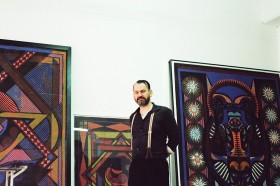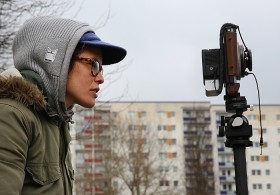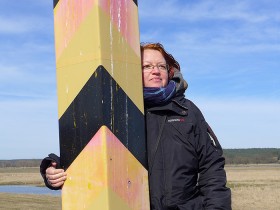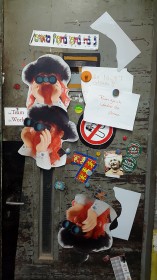I’m meeting Georg Sadowicz in his atelier in Berlin-Hohenschönhausen. The Berlin-based artist was born in Liegnitz, Poland, on the German border. Since April, two of his pieces – precursors to larger work – have been made available to visitors as a limited run in the Jewish Museum Berlin’s art vending machine. They are titled, “The Cantor” and “The Mill.” Sadowicz’s atelier is a mere hundred meters from the grounds of a former Stasi detention center, now a memorial site. The sight of it troubles me, but the unease vanishes as soon as I step into Sadowicz’s atelier. → continue reading
Escaping the Escape Points
Art Against Forgetting
History cannot be captured in a single form. Not in brass, not in metal. That is what Hadas Tapouchi says. The Berlin-based Israeli artist believes that monuments and inscriptions miss the actual sense of commemoration. This type of remembrance would be an inevitable path towards forgetting.
Undoubtedly, Hadas works against forgetting. Upon our first meeting at her Tel Aviv apartment about four years ago, the artist’s rendered self-portrait in prisoner’s garb immediately jumped out at me. It was one of the precursors to her project, “The Third Generation“. A countless number of portraits since followed – portraits of mutual friends, the author himself, as well as young men and women between Berlin, Tel Aviv and Ramallah. → continue reading
A “kosher gnome” and everything’s ok? A conversation with Anna Adam
It’s not easy to find the way there. Good thing that the artist picked me up at the nearest subway station in Berlin’s Wedding district. Together we cross the courtyards of various businesses, pass a halal diner, climb a staircase, and suddenly we’re standing in front of the door of her atelier. Hardly has Anna opened it when I see the “kosher gnome”, observing the world through his binoculars.
It’s this figure that the artist reproduced in paper cut-out form on a card for our art vending machine: you cut the card and fold it to create a three-dimensional object. The instructions state that you should set him in your kitchen and then everything will be ok.
Anna, what does the odd name “kosher gnome” mean? How do “kosher” and “gnome” even fit together? How will everything be ok? I’m confused.
At home, a wichtel (in the original German) is an important little man. There are a lot of these “important men”. My “kosher gnome” was born in 2002. He’s definitely supposed to be confusing. “Kosher” and “gnome” fit together because I committed myself to the task of “healing the German-Jewish sickness”, as I call it. To that end I work with satirical means, which – unlike comedy – take everyday politics as a starting point.
You mentioned the year it was born. What were the circumstances of the “kosher gnome”‘s birth? → continue reading



